4.1 Fabric register
The cultural significance of the lighthouse resides in its fabric, and also in its intangible aspects, such as the meanings people ascribe to it, and the connections to other places and things. The survival of its cultural value depends on a well-informed understanding of what is significant, and on clear thinking about the consequences of change. The Burra Charter sets out good practice for conserving cultural significance.
Below, each part of the lighthouse is listed and the description, condition and significance of each part is discussed. Criterion listed under ‘Heritage Significance’ refer to the criterion satisfied within the specific Commonwealth heritage listing (see ‘Section 5.1’).
Lighthouse feature: Lantern roof
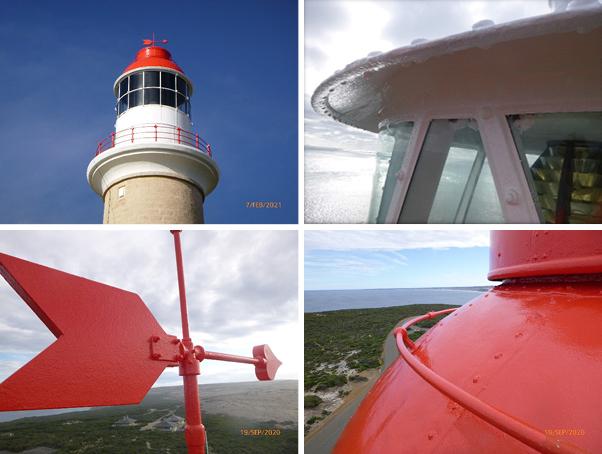 (© AMSA)
(© AMSA)
Description and condition
1909 Chance Bros part-spherical dome of copper sheets lapped and screwed.
• Ribs – not visible but presumed to be cast iron radial ribs
• Inner skin – copper sheets screw fixed to ribs
• Ventilator – drum type with wind vane attached
• Wind vane – fixed
• Gutter – circular ring of cast iron pieces bolted together
• External ladder – curved iron ladder fixed to outside of roof
• Handrails – one circular hand rail attached to lantern roof, another attached to top of ventilator drum
• Ladder rail – has been removed and stored on the intermediate landing within the lighthouse
• Curtain rail – continuous rail attached to inner skin of roof
• Drip tray – copper dish suspended under ventilator, with central hole for heat tube
| Finish: | painted |
| Condition: | intact and sound |
| Integrity: | high |
| Significance: | high |
| Maintenance: | keep in service, prepare and repaint at normal intervals |
| Rectification works: | none |
Heritage significance: High
The lantern roof is an original feature of the last lighthouse to be built in South Australia by the State Government, a site associated with the State’s maritime and economic history (criterion a).
The lantern roof is an original feature of a relatively intact early 20th century lightstation complex (criterion d).
The lantern roof contributes to the prominent aesthetic qualities of the tower (criterion e).
Lighthouse feature: Lantern glazing
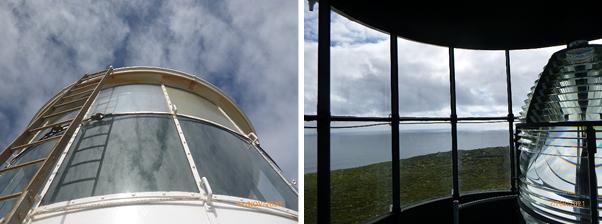 (© AMSA)
(© AMSA)
Description and condition
1909 Chance Bros, cylindrical in form.
• Panes – curved rectangular glass, three tiers
• Astragals – vertical astragals of rectangular section iron, bolted to gutter ring at top, and to lantern base below. Horizontal astragals of triangular section.
| Finish: | astragals, cover strips and blank panels: painted blank panels are formed of FRP |
| Condition: | intact and sound |
| Integrity: | high |
| Significance: | high |
| Maintenance: | keep in service, reglaze as necessary, prepare and repaint at normal intervals |
| Rectification works: | none |
Heritage significance: High
The lantern glazing is an original feature of the last lighthouse to be built in South Australia by the State Government, a site associated with the State’s maritime and economic history (criterion a).
The lantern glazing is an original feature of a relatively intact early 20th century lightstation complex (criterion d).
The lantern glazing is an original feature of the lighthouse and contributes to its prominent aesthetic qualities (criterion e).
Lighthouse feature: Internal catwalk
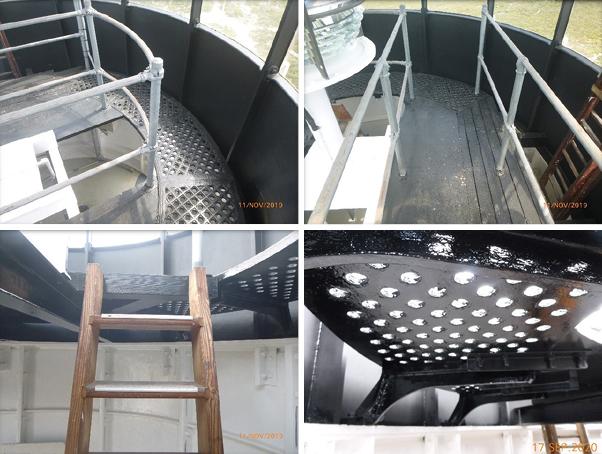 (© AMSA)
(© AMSA)
Description and condition
Post 1910 Chance Bros, cast iron lattice floor panels supported on solid cast iron brackets bolted to top of the lantern base.
• 1957 modification for acetylene conversion – five catwalk floor panels and their brackets removed, and infill floor installed at catwalk level, with timber planks supported on rolled steel joists spanning across the top of the lantern base. Galvanized pipe handrails and stanchions around access openings.
• Ladder – fixed timber ladder with treads housed into strings
| Finish: | painted |
| Condition: | intact and sound |
| Integrity: | high |
| Significance: | high |
| Maintenance: | keep in service, prepare and repaint at normal intervals |
| Rectification works: | none |
Heritage significance: High
The internal catwalk is an early feature of the last lighthouse to be built in South Australia by the State Government, a site associated with the State’s maritime and economic history (criterion a).
The internal catwalk is an early feature of a relatively intact early 20th century lightstation complex (criterion d).
Lighthouse feature: Lantern base
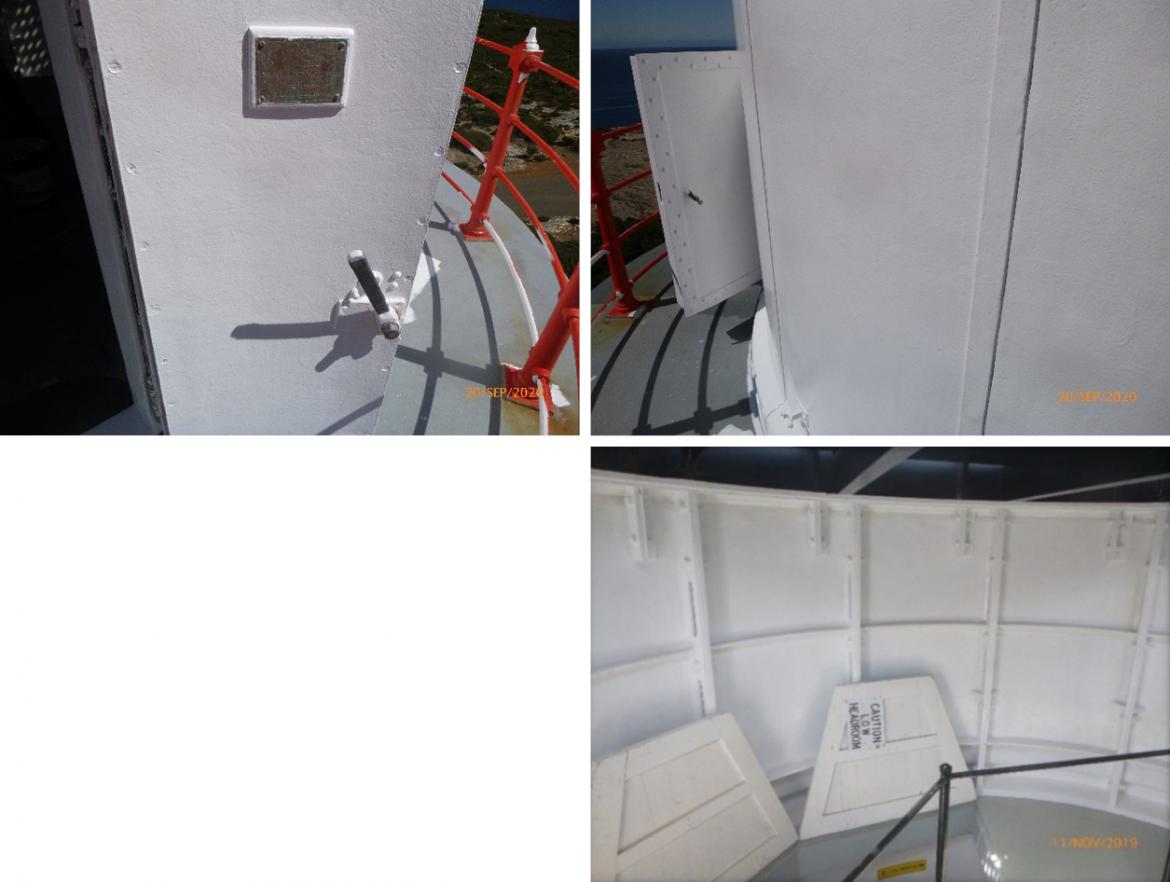 (© AMSA)
(© AMSA)
Description and condition
1909 Chance Bros, cylindrical in form. Curved panels of cast iron bolted together with flanged joints.
• Internal lining – none (removed)
• Vents – two horizontal slots in the bottom exterior of each panel, blocked off
• Door – Chance Bros, iron skin with flat frame applied outside; iron inner frame and lining. Copper alloy hinges. Copper alloy mortise lock; inside knob replaced by steel lever, but outside bar handle still in place. Maker’s plaque attached to door.
| Finish: | painted |
| Condition: | intact and sound |
| Integrity: | high |
| Significance: | high |
| Maintenance: | keep in service, prepare and repaint at normal intervals |
| Rectification works: | none |
Heritage significance: High
The lantern base is an original feature of the last lighthouse to be built in South Australia by the State Government, a site associated with the State’s maritime and economic history (criterion a).
The lantern base is an original feature of a relatively intact early 20th century lightstation complex (criterion d).
The lantern base is an original feature of the lighthouse and contributes to its prominent aesthetic qualities (criterion e).
Lighthouse feature: Lantern floor
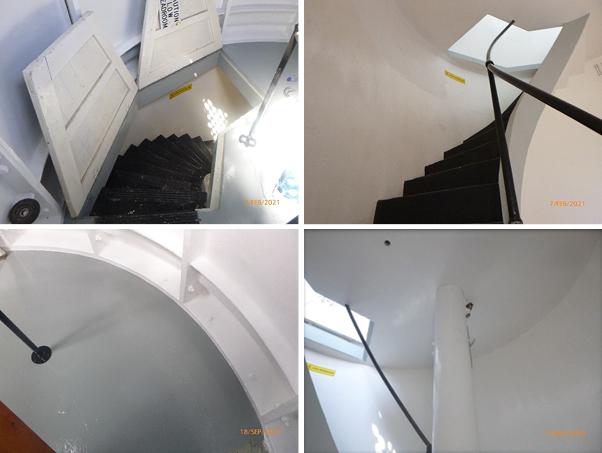 (© AMSA)
(© AMSA)
Description and condition
1909 reinforced concrete floor slab.
• Access – stair covered by two trapezoidal timber framed and sheeted covers. Steel handrail.
| Finish: | painted |
| Condition: | intact and sound |
| Integrity: | high |
| Significance: | high |
| Maintenance: | keep in service, prepare and repaint at normal intervals |
| Rectification works: | none |
Heritage significance: High
The lantern floor is an original feature of the last lighthouse to be built in South Australia by the State Government, a site associated with the State’s maritime and economic history (criterion a).
The lantern floor is an original feature of a relatively intact early 20th century lightstation complex (criterion d).
Lighthouse feature: Lens assembly
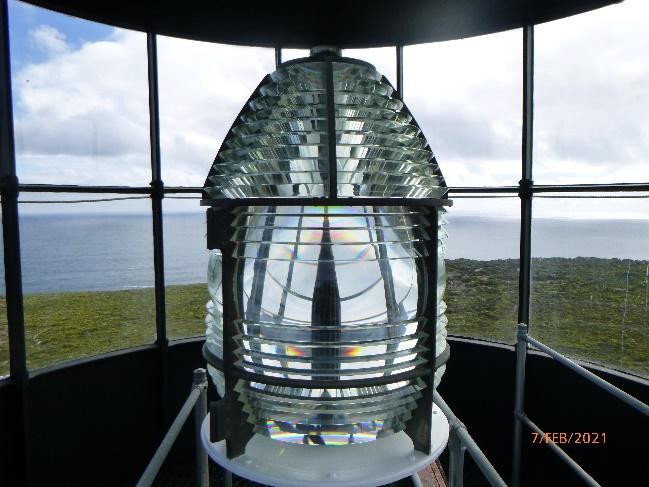 (© AMSA)
(© AMSA)
Description and condition
1957 Chance Bros 375mm focal radius fixed lens assembly.
| Condition: | intact and sound |
| Integrity: | high |
| Significance: | moderate |
| Maintenance: | keep in service, prepare and repaint at normal intervals |
| Rectification works: | none |
Heritage significance: Moderate
The 1957 Chance Bros. lens is an important addition to the last lighthouse to be built in South Australia by the State Government, a site associated with the State’s maritime and economic history (criterion a).
Lighthouse feature: Optical apparatus
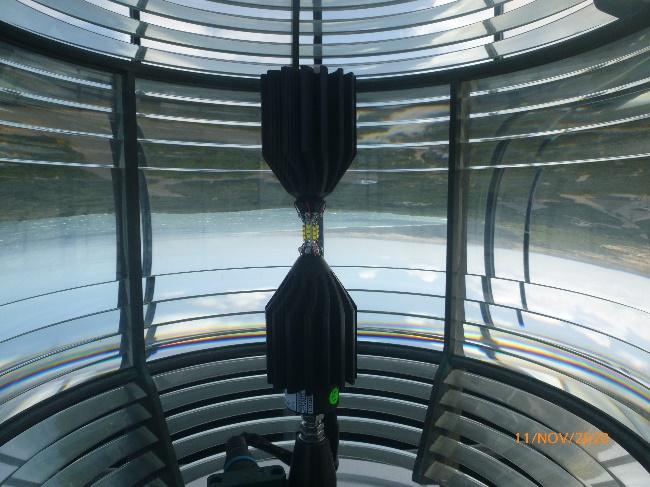 (© AMSA)
(© AMSA)
Description and condition
Sealite SL-LED-216-W.
| Condition: | intact and sound |
| Integrity: | high |
| Significance: | low |
| Maintenance: | keep in service |
| Rectification works: | none |
Heritage significance: Low
The optical apparatus is of low significance.
Lighthouse feature: Pedestal
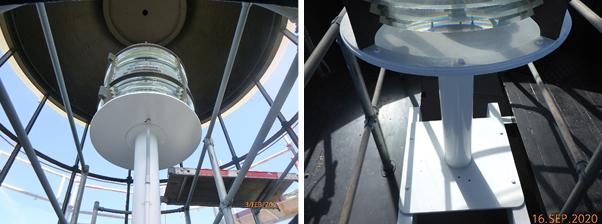 (© AMSA)
(© AMSA)
Description and condition
1957 steel tubular post welded to square base plate and circular top plate. The pedestal is supported on two rolled steel beams.
| Condition: | sound |
| Integrity: | medium |
| Significance: | low |
| Maintenance: | keep in service, prepare and repaint at normal intervals |
| Rectification works: | none |
Heritage significance: Low
The 1957 pedestal is of low significance.
Lighthouse feature: Balcony floor
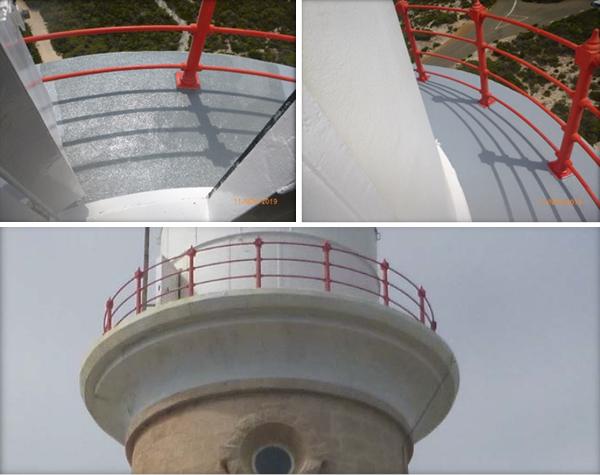 (© AMSA)
(© AMSA)
Description and condition
1909 reinforced concrete slab.
| Finish: | membrane painted |
| Condition: | intact and sound |
| Integrity: | high |
| Significance: | high |
| Maintenance: | keep in service, prepare and repaint at normal intervals |
| Rectification works: | none |
Heritage significance: High
The balcony floor is an original feature of the last lighthouse to be built in South Australia by the State Government, a site associated with the State’s maritime and economic history (criterion a).
The balcony floor is an original feature of a relatively intact early 20th century lightstation complex (criterion d).
The balcony floor is an original feature of the lighthouse and contributes to its prominent aesthetic qualities (criterion e).
Lighthouse feature: Balcony balustrade
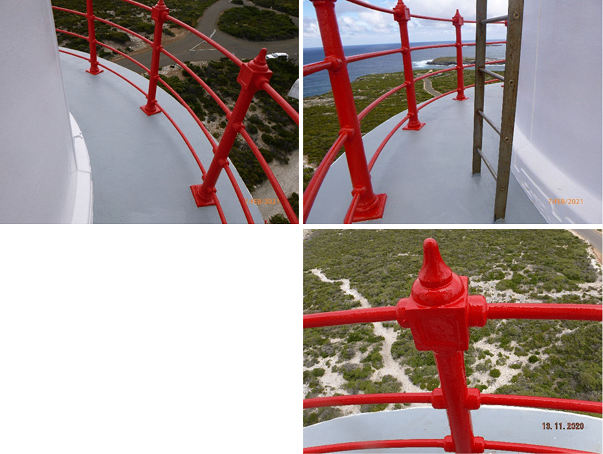 (© AMSA)
(© AMSA)
Description and condition
1909 Chance Bros cast iron stanchions with four iron pipe rails.
| Finish: | painted |
| Condition: | intact and sound |
| Integrity: | high |
| Significance: | high |
| Maintenance: | keep in service, prepare and repaint at normal intervals |
| Rectification works: | none |
Heritage significance: High
The balcony balustrades are an original feature of the last lighthouse to be built in South Australia by the State Government, a site associated with the State’s maritime and economic history (criterion a).
The balcony balustrades are an original feature of a relatively intact early 20th century lightstation complex (criterion d).
The balcony balustrades are an original feature of the lighthouse and contributes to its prominent aesthetic qualities (criterion e).
Lighthouse feature: Walls
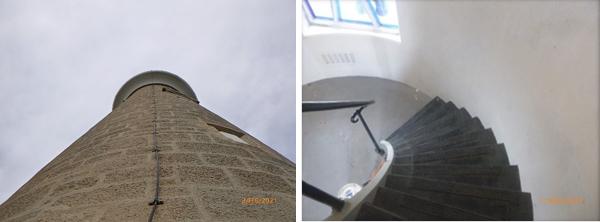 (© AMSA)
(© AMSA)
Description and condition
1909 sandstone walls, chisel finish. Plastered inside.
| Finish: | external walls: bare stone internal walls: painted |
| Condition: | intact and sound, internal paint peeling in some areas, pointing in stone dressing around circular windows needs some minor repair |
| Integrity: | high |
| Significance: | high |
| Maintenance: | keep in service, monitor condition of pointing and stonework |
| Rectification works: | none |
Heritage significance: High
The walls are an original feature of the last lighthouse to be built in South Australia by the State Government, a site associated with the State’s maritime and economic history (criterion a).
The walls are an original feature of a relatively intact early 20th century lightstation complex (criterion d).
The walls are an original feature of the lighthouse and contributes to its prominent aesthetic qualities (criterion e).
Lighthouse feature: Windows
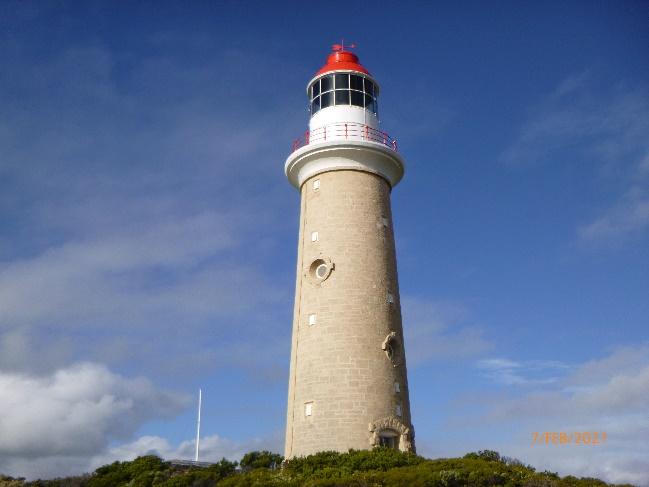 (© AMSA)
(© AMSA)
Description and condition
1909 circular windows with glass panes fixed into cast iron frames built into stonework. Rock faced stone dressings around the outside of the openings.
| Finish: | cast iron frames: painted glass: clear |
| Condition: | intact and sound |
| Integrity: | high |
| Significance: | high |
| Maintenance: | keep in service, prepare and repaint at normal intervals |
| Rectification works: | none |
Heritage significance: High
The windows are an original feature of the last lighthouse to be built in South Australia by the State Government, a site associated with the State’s maritime and economic history (criterion a).
The windows are an original feature of a relatively intact early 20th century lightstation complex (criterion d).
Lighthouse feature: Auxiliary light windows
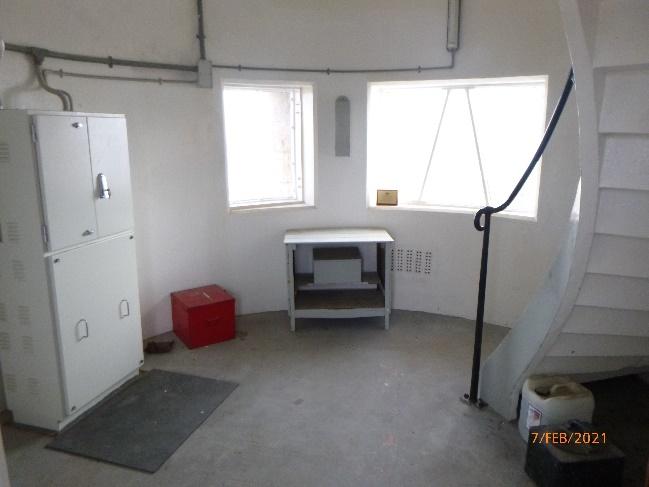 (© AMSA)
(© AMSA)
Description and condition
Two 1909 rectangular windows with glass panes fixed in iron frames built into stonework. Rock faced stone dressings around the outside of the openings.
| Condition: | intact and sound |
| Integrity: | high |
| Significance: | high |
| Maintenance: | keep in service, prepare and repaint at normal intervals, reseal as necessary |
| Rectification works: | none |
Heritage significance:
The auxiliary light windows are an original feature of the last lighthouse to be built in South Australia by the State Government, a site associated with the State’s maritime and economic history (criterion a).
The auxiliary light windows are an original feature of a relatively intact early 20th century lightstation complex (criterion d).
Lighthouse feature: Vents
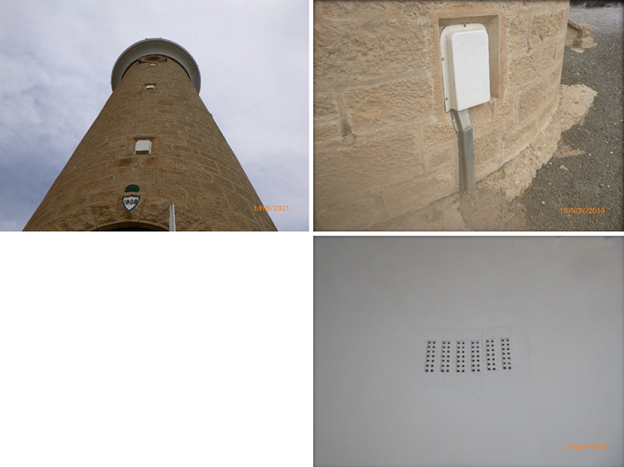 (© AMSA)
(© AMSA)
Description and condition
1909 vent openings incorporated in the tower masonry walls, with recent plastic weatherproof fixed vent cowls.
| Finish: | bare plastic |
| Condition: | sound |
| Integrity: | high |
| Significance: | openings: high cowls: low |
| Maintenance: | keep in service |
| Rectification works: | none |
Heritage significance: High
The vent openings are an original feature of the last lighthouse to be built in South Australia by the State Government, a site associated with the State’s maritime and economic history (criterion a).
The vent openings are an original feature of a relatively intact early 20th century lightstation complex (criterion d).
Lighthouse feature: Doors
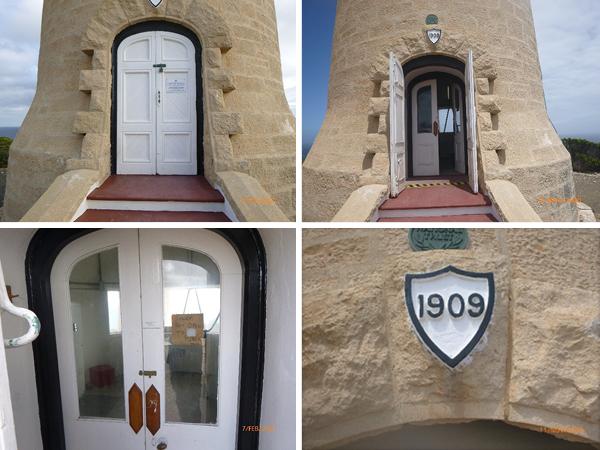 (© AMSA)
(© AMSA)
Description and condition
1909 timber doors in timber frames with arched tops.
• Outer doors – a pair of framed door leaves, each with three panels of tongue and groove jointed boards, secured outside with pad-bolt and CLS padlock. Date is mounted above the outer doors.
• Inner doors – a pair of half-glazed door leaves, each with single plain bottom panel. Both leaves have spring closers. One leaf has top and bottom bolts with extended handles, the other has iron cased rim-lock.
| Finish: | timber: painted glass: clear |
| Condition: | intact and sound |
| Integrity: | high |
| Significance: | high |
| Maintenance: | keep in service, prepare and repaint as necessary |
| Rectification works: | none |
Heritage significance: High
The doors are an original feature of the last lighthouse to be built in South Australia by the State Government, a site associated with the State’s maritime and economic history (criterion a).
The doors are an original feature of a relatively intact early 20th century lightstation complex (criterion d).
The doors are an original feature of the lighthouse and contribute to its prominent aesthetic qualities (criterion e).
Lighthouse feature: Entrance stair
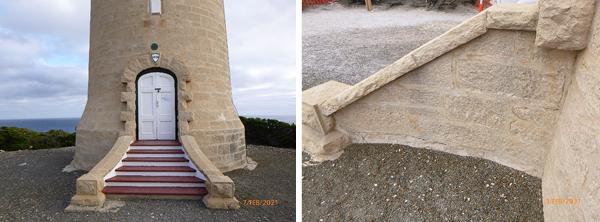 (© AMSA)
(© AMSA)
Description and condition
1909 masonry entrance stair with sandstone strings, slate treads, concrete risers.
| Finish: | sandstone: base other surfaces: painted |
| Condition: | intact and sound |
| Integrity: | high |
| Significance: | high |
| Maintenance: | keep in service, prepare and repaint as necessary |
| Rectification works: | none |
Heritage significance: High
The entrance stair is an original feature of the last lighthouse to be built in South Australia by the State Government, a site associated with the State’s maritime and economic history (criterion a).
The entrance stair is an original feature of a relatively intact early 20th century lightstation complex (criterion d).
The entrance stair is an original feature of the lighthouse and contributes to its prominent aesthetic qualities (criterion e).
Lighthouse feature: Intermediate floors
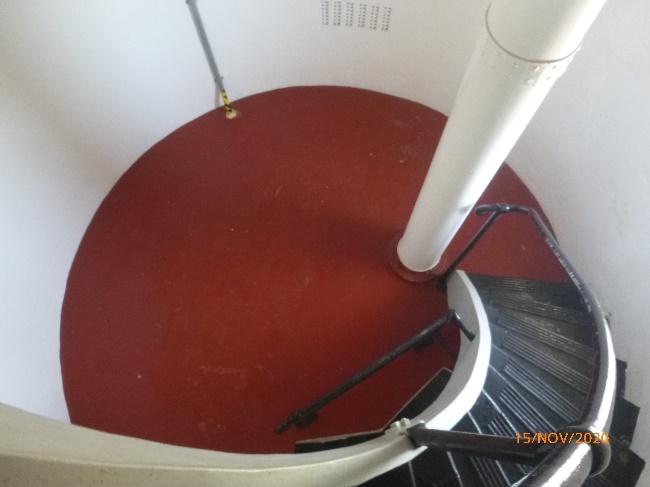 (© AMSA)
(© AMSA)
Description and condition
Three 1909 reinforced concrete slab floors.
Ladder rails earlier removed from the lantern are labelled and stored on site on an intermediate floor.
| Finish: | painted |
| Condition: | intact and sound |
| Integrity: | high |
| Significance: | high |
| Maintenance: | keep in service, prepare and repaint as necessary |
| Rectification works: | none |
Heritage significance: High
The intermediate floors are an original feature of the last lighthouse to be built in South Australia by the State Government, a site associated with the State’s maritime and economic history (criterion a).
The intermediate floors are an original feature of a relatively intact early 20th century lightstation complex (criterion d).
Lighthouse feature: Stairs
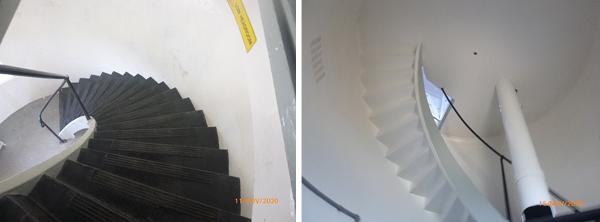 (© AMSA)
(© AMSA)
Description and condition
1909 reinforced concrete geometric stairs with integral string. Single iron handrail on iron stanchions. Extruded zinc strip on lip of each tread.
| Finish: | painted |
| Condition: | intact and sound |
| Integrity: | high |
| Significance: | high |
| Maintenance: | keep in service, prepare and repaint as necessary |
| Rectification works: | none |
Heritage significance: High
The stairs are an original feature of the last lighthouse to be built in South Australia by the State Government, a site associated with the State’s maritime and economic history (criterion a).
The stairs are an original feature of a relatively intact early 20th century lightstation complex (criterion d).
Lighthouse feature: Weight tube
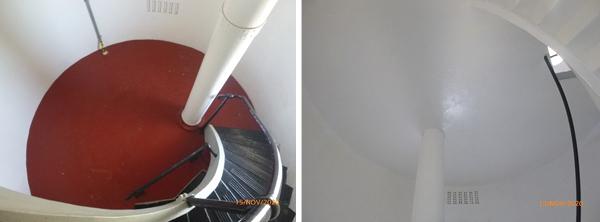 (© AMSA)
(© AMSA)
Description and condition
1909 riveted iron plate tube, off-set from the centre of the tower; between the lantern floor and the first floor of the tower.
| Finish: | painted |
| Condition: | intact and sound |
| Integrity: | high |
| Significance: | high |
| Maintenance: | keep in service, prepare and repaint as necessary |
| Rectification works: | none |
Heritage significance: High
The weight tube is an original feature of the last lighthouse to be built in South Australia by the State Government, a site associated with the State’s maritime and economic history (criterion a).
The weight tube is an original feature of a relatively intact early 20th century lightstation complex (criterion d).
Lighthouse feature: Ground floor
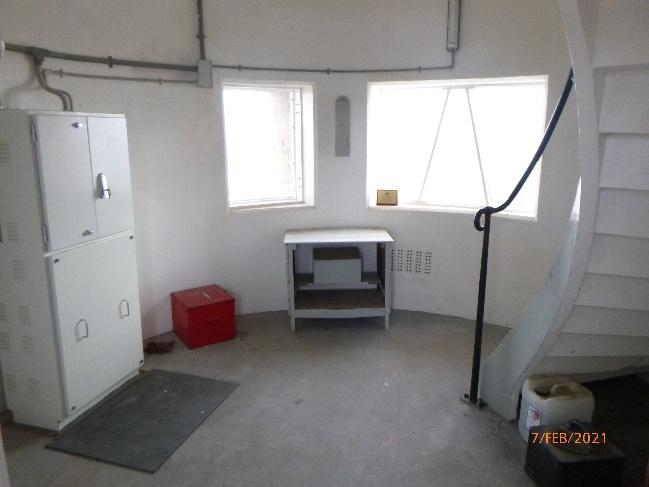 (© AMSA)
(© AMSA)
Description and condition
1909 reinforced concrete floor slab.
| Finish: | painted |
| Condition: | intact and sound |
| Integrity: | high |
| Significance: | high |
| Maintenance: | keep in service, prepare and repaint as necessary |
| Rectification works: | none |
Heritage significance: High
The ground floor is an original feature of the last lighthouse to be built in South Australia by the State Government, a site associated with the State’s maritime and economic history (criterion a).
The ground floor is an original feature of a relatively intact early 20th century lightstation complex (criterion d).
Lighthouse feature: Power supply
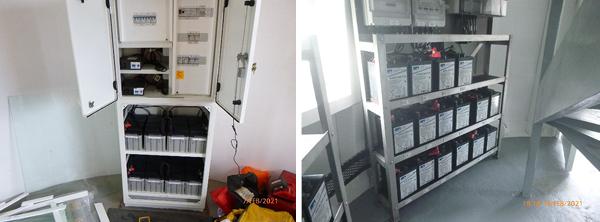 (© AMSA)
(© AMSA)
Description and condition
Mains powered with UPS arrangement. All equipment and batteries housed in metal cabinet on ground floor.
| Condition: | operational |
| Integrity: | high |
| Significance: | low |
| Maintenance: | keep in service |
| Rectification works: | none |
Heritage significance: Low
The power supply is of low significance.
Lighthouse feature: Gravel apron
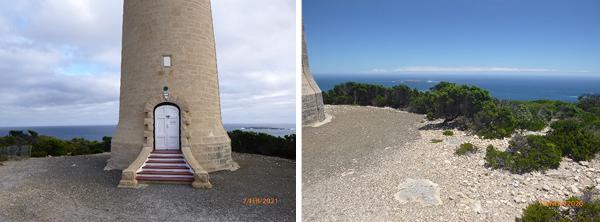 (© AMSA)
(© AMSA)
Description and condition
Gravel apron approximately 4.0m wide around the base of the tower.
| Finish: | gravel surface |
| Condition: | intact and sound |
| Integrity: | high |
| Significance: | high |
| Maintenance: | preserve gravel apron |
| Rectification works: | none |
Heritage significance: High
The gravel apron remains part of the original footprint of the last lighthouse to be built in South Australia by the State Government, a site associated with the State’s maritime and economic history (criterion a).
The gravel apron remains part of the original footprint of a relatively intact early 20th century lightstation complex (criterion d).
4.2 Related object and associated AMSA artefacts
The following AMSA artefact/s are currently located at Cape du Couedic Lighthouse.
| Artefact description: Thermometer mounted in custom built wooden case |
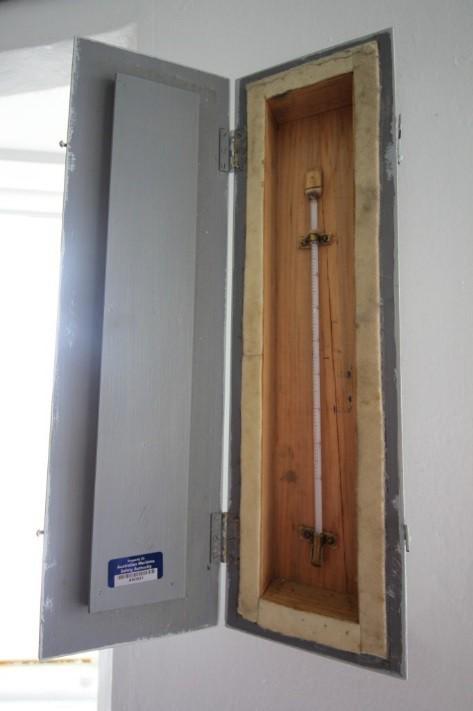 (© AMSA)
(© AMSA)
|
| Maximo ID: AR0551 | |
| Location in lighthouse: Ground level wall | |
| Condition: Good |
4.3 Comparative analysis
Cape du Couedic Lighthouse bears some similarities with Barrenjoey Head Lighthouse (New South Wales). Constructed in 1881 under the guidance of Colonial Architect James Barnet, Barrenjoey Lighthouse was constructed of local sandstone which was left bare, as was done with Cape du Couedic. Both Barrenjoey and Cape du Couedic were originally fitted with a Chance Bros. lantern, Barrenjoey’s being slightly smaller measuring 700mm compared to du Couedic’s 920mm.
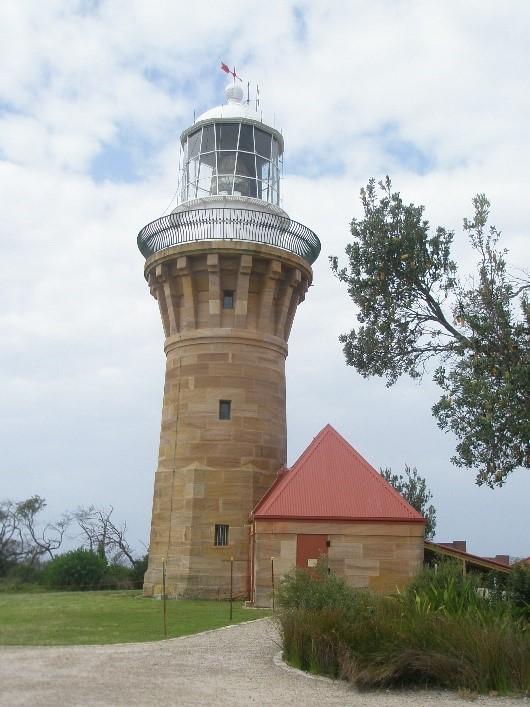 Figure 14. Barrenjoey Lighthouse, NSW (© AMSA, 2009)
Figure 14. Barrenjoey Lighthouse, NSW (© AMSA, 2009)
|
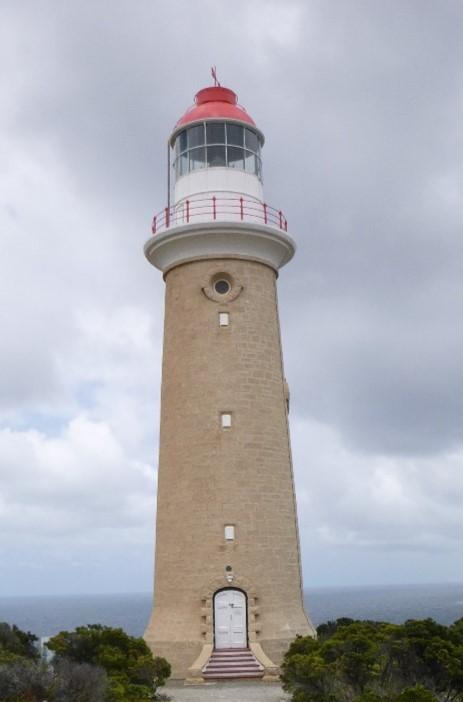 Figure 15. Cape du Couedic Lighthouse (© AMSA, 2021)
Figure 15. Cape du Couedic Lighthouse (© AMSA, 2021)
|